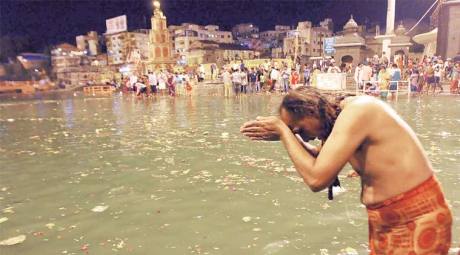“It is wonderful, the power of a faith like that, that can make multitudes upon multitudes of the old and weak and the young and frail enter without hesitation or complaint upon such incredible journeys and endure the resultant miseries without repining. It is done in love, or it is done in fear; I do not know which it is. No matter what the impulse is, the act born of it is beyond imagination, marvellous to our kind of people, the cold whites.” — Mark Twain at a Kumbha Mela in 1895
Dreadlocked Indian holy men and waves of Hindu pilgrims washed away their sins with a religious dip on the first main bathing day of India’s massive Kumbh Mela festival.
The sadhus, naked and with their faces painted, danced and chanted as they jumped onto a holy ghat at a temple in the western Indian state of Maharashtra.
Tens of thousands celebrated the ‘Shahi Snan’, meaning “royal bath”, with Hindu sects following one another in shedding their orange robes before splashing joyously into the sacred water at Nashik.
Their time to bathe lasted just seconds, however, as hundreds of police officers frantically blew their whistles to signal for them to hastily make way for the next wave of devotees.
The Kumbh Mela, a celebration of faith in which Hindus bathe in a sacred river, is held every third year and is rotated between four holy sites.
As a result, it takes place at Nashik every 12 years and although it isn’t on the same scale as the editions on the Ganga at Haridwar and Triveni at Prayag (Allahabad), it still draws millions of pilgrims.
Organisers had increased safety measures in a bid to avoid a repeat of a deadly stampede at the same venue 12 years ago, and said the mass bathe had so far passed without major incident.
“No, nothing like that, it all went well,” K. Moghe, the district information officer for Nashik, said.
 Thirty-nine pilgrims were trampled to death when the religious festival was last held on the banks of the Godavari river in Nashik, around 160 kilometres (100 miles) from Mumbai, in 2003.
Thirty-nine pilgrims were trampled to death when the religious festival was last held on the banks of the Godavari river in Nashik, around 160 kilometres (100 miles) from Mumbai, in 2003.
The crush was believed to have been triggered when a sadhu, or holy man, threw coins into a crowd of pilgrims who were growing increasingly impatient at having to wait for their turn to bathe.
When the coins were thrown they scrambled to gather them, resulting in dozens of people suffocating, according to reports at the time.
Nashik is unique out of the four venues in that it has two main bathing sites, Panchavati on the Godavari river in Nashik and nearby Trimbakeshwar temple ghat, stretching the emergency services across a wide area.
For this year’s edition, officials changed the routes to the ghats to avoid steep slopes while a massive police presence of around 20,000 officers ensured little overcrowding and first aid workers stood ready.
The first sadhus entered the water at Trimbakeshwar shortly before 4 am with a continuous flow of devotees rejoicing in the bath for several hours afterwards.
The Kumbh Mela has its origins in Hindu mythology, which describes how a few drops of the nectar of immortality fell on all of the places that host the festival, the fourth being Ujjain in central India.
Between eight and 10 million pilgrims are expected to attend the two-month-long Hindu festival this year. Its official opening was marked with a low-key flag raising ceremony in Nashik on July 14. There are two main bathing dates left, on September 13 and September 18. – Asia Times, 29 August 2015
See also
Filed under: india | Tagged: festivals, godavari river, hindu festivals, hinduism, india, kumbh mela, kumbha mela 2015, naga sadhus, ram kund, sannyasi, triyambakeshwar |






































Akhand Jyoti at Kumbh: Lamp with the longest wick, 3617 km, to burn for 108 days – Indian Express – PTI – Nashik – July 17, 2015
Maha Kumbh Akhand Jyoti, a one-of-its-kind lamp having the longest wick of 3,617-km, the same as the distance from Kashmir to Kanykumari, was illuminated on the opening day of the Simhastha Kumbh here and will continue to burn for all the 108 days.
According to the Kumbh organisers, the lotus-shape lamp, lit on July 14 by Sena chief Uddhav Thackeray during the flag hoisting (dharma dhwaja rohan) ceremony, is 8-ft high and will hold the Akhand Jyot up to October 10 as a symbol of India’s unity and diversity.
This unique bronze lamp, with a radius of 8 metres, is fed with hundreds of litres of Til (sesame) oil everyday and its 4-inch thick wick is driven by hand-held machines, former cabinet minister of Maharashtra and Sena leader Babanrao Gholap said.
The wick, prepared by cotton threads woven together has been bundled into a half-kilometre long ball kept nearby.
Describing the importance of this gigantic Diya, erected adjacent to the Sadhugram, Shri Ramanujacharya Himalay Baba, under whose guidance the lamp was set up said, “This is a unique way to unify devotees spiritually.”
“Our country is spread from Kashmir to Kanyakumari and this is why we have chosen to keep the wick of the lamp akin to the distance between them (two destinations) to unite the country forever culturally,” he said.
“Whosoever comes here and gets the Darshan of this Diya, is bestowed with all sorts of blessings of health, wealth and spirituality,” he added.
Many devotees visiting the Kumbh were seen overwhelmed by the size and structure of this lamp.
Vijay Kumar, an industrialist from Patna who visited the place and got a ‘darshan’ of the Diya said, “Of course, the Diya has been structured very well with a blend of science and spirituality, but the religious atmosphere here makes all the difference.”
LikeLike
Majestic pictures. I missed this one… Hopefully Ujjain next year. Fingers crossed.
LikeLike